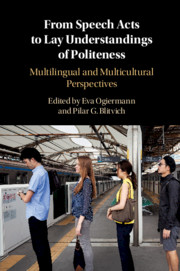Book contents
- From Speech Acts to Lay Understandings of Politeness
- From Speech Acts to Lay Understandings of Politeness
- Copyright page
- Contents
- Figures
- Tables
- Contributors
- Im/politeness between the Analyst and Participant Perspectives: An Overview of the Field
- Part I Concepts and Cultural Norms Underlying Speech Acts
- 1 Offers in Greek Revisited
- 2 Politeness, Praising, and Identity Construction in a Greek Food Blog
- 3 Online Compliments of Iranian Facebook Users
- 4 Qué perfección : Complimenting Behaviour among Ecuadorian Teenage Girls on Instagram
- 5 Not All Positive: On the Landscape of Thanking Items in Cypriot Greek
- 6 Researching Im/politeness in Face-to-Face Interactions: On Disagreements in Polish Homes
- Part II Concepts and Cultural Norms Underlying Politeness
- Epilogue: Personal Encounters with Politeness Research
- Index
- References
4 - Qué perfección : Complimenting Behaviour among Ecuadorian Teenage Girls on Instagram
from Part I - Concepts and Cultural Norms Underlying Speech Acts
Published online by Cambridge University Press: 14 June 2019
- From Speech Acts to Lay Understandings of Politeness
- From Speech Acts to Lay Understandings of Politeness
- Copyright page
- Contents
- Figures
- Tables
- Contributors
- Im/politeness between the Analyst and Participant Perspectives: An Overview of the Field
- Part I Concepts and Cultural Norms Underlying Speech Acts
- 1 Offers in Greek Revisited
- 2 Politeness, Praising, and Identity Construction in a Greek Food Blog
- 3 Online Compliments of Iranian Facebook Users
- 4 Qué perfección : Complimenting Behaviour among Ecuadorian Teenage Girls on Instagram
- 5 Not All Positive: On the Landscape of Thanking Items in Cypriot Greek
- 6 Researching Im/politeness in Face-to-Face Interactions: On Disagreements in Polish Homes
- Part II Concepts and Cultural Norms Underlying Politeness
- Epilogue: Personal Encounters with Politeness Research
- Index
- References
Summary
Placencia’s contribution to the volume complements Eslami et al.’s chapter in that it looks at compliments exchanged on Instagram, a social networking site aimed explicitly at sharing pictures. The study analyzes comments on solo shots posted by older Ecuadorian teenage girls over a period of 12 months, and the interpretation of the responses is backed up with informal interviews. The pictures analyzed by Placencia serve as invitations for positive assessment, and it is argued that the complimenters compete with each other to offer the most original ‘gift’ in the form of a compliment. Their creativity is conveyed through lexical choices, use of irony, mock impoliteness, and macho talk with sexual connotations (used in jest). The compliments are characterized by exaggeration and high emotional involvement, expressed through different means. They tend to be brief, with a strong reliance on ellipsis and pictorial forms. The affordances of the medium contribute to the multimodal character of the compliments, reflected in the use of emojis, prosodic orthography, and hashtags, linking the compliments with images.
Keywords
- Type
- Chapter
- Information
- From Speech Acts to Lay Understandings of PolitenessMultilingual and Multicultural Perspectives, pp. 93 - 116Publisher: Cambridge University PressPrint publication year: 2019
References
- 8
- Cited by



